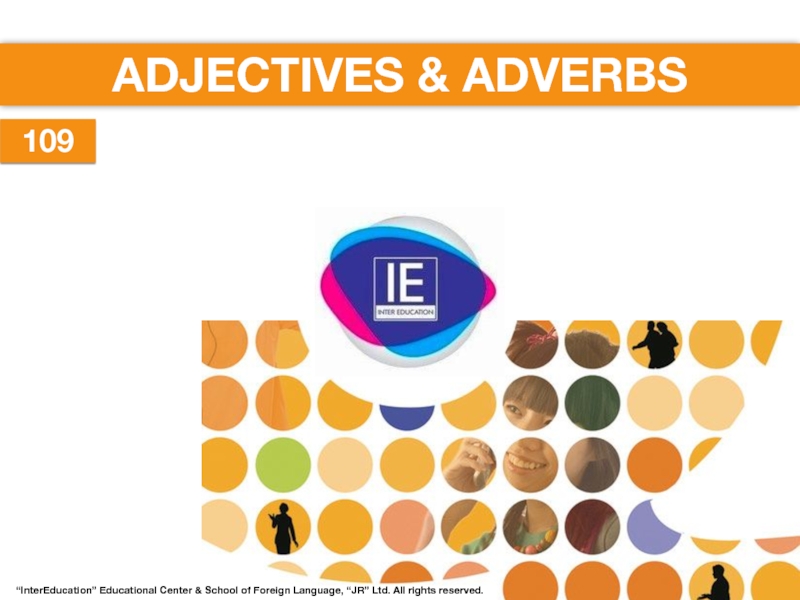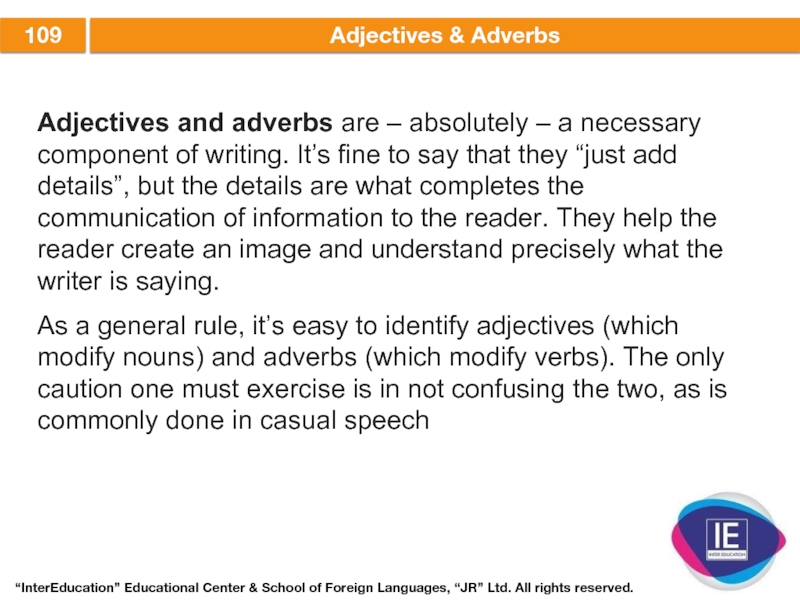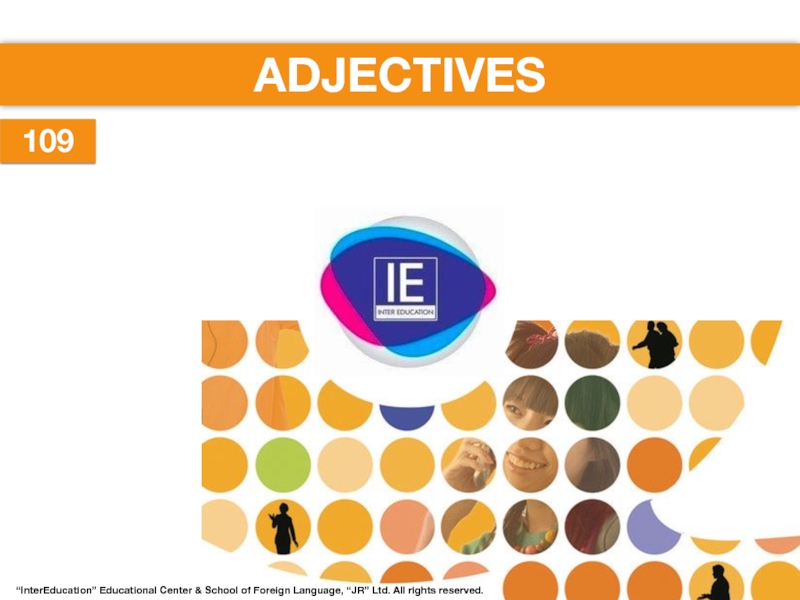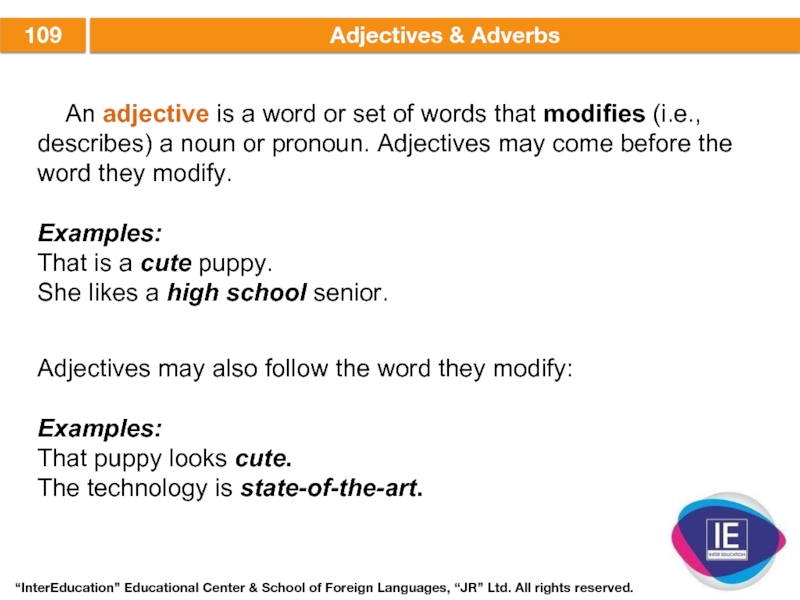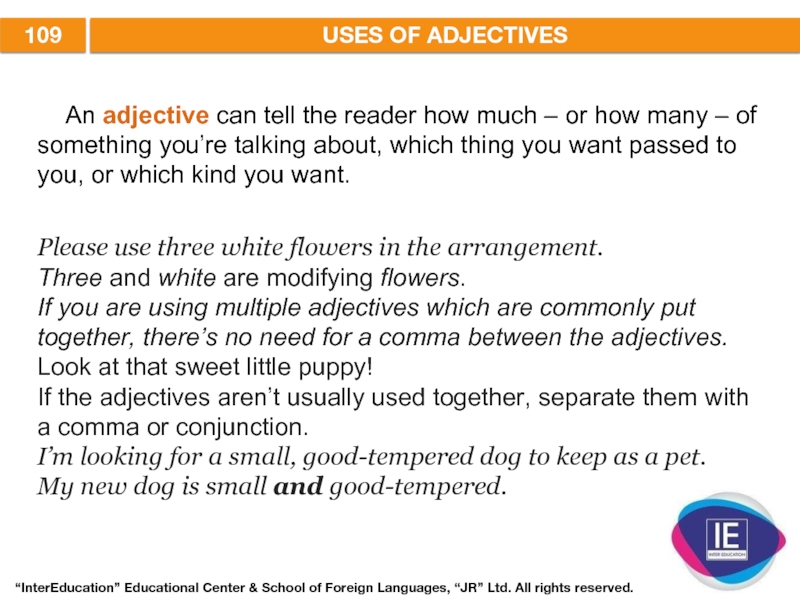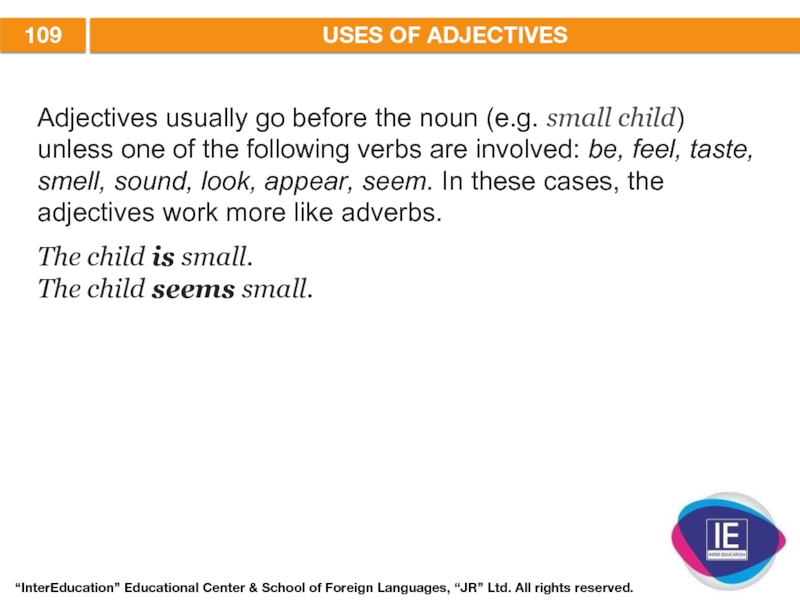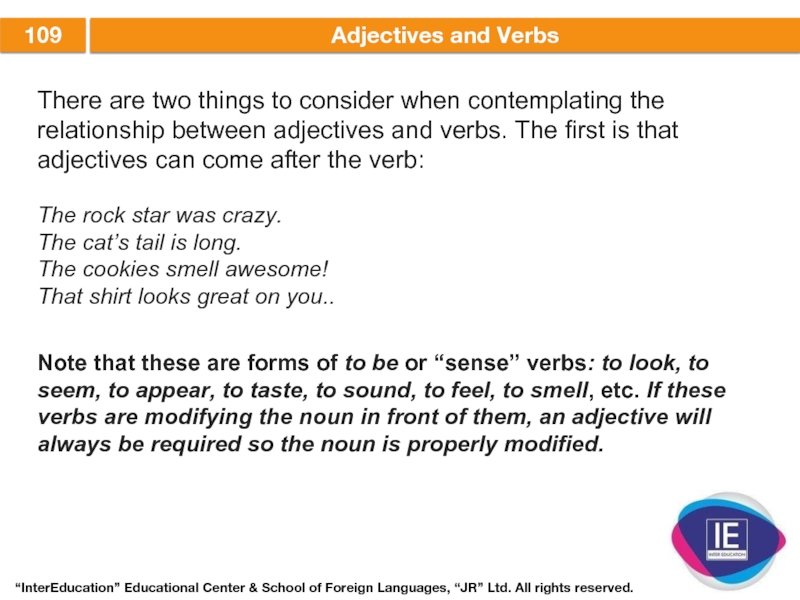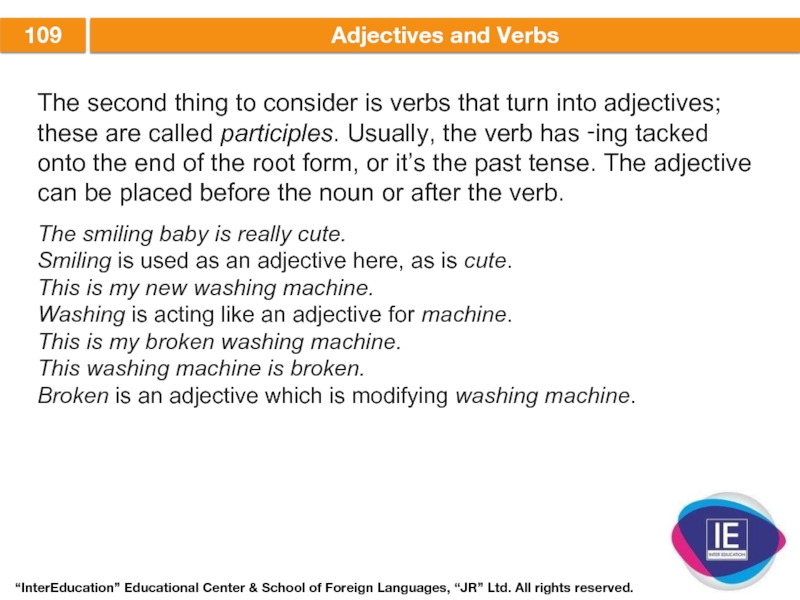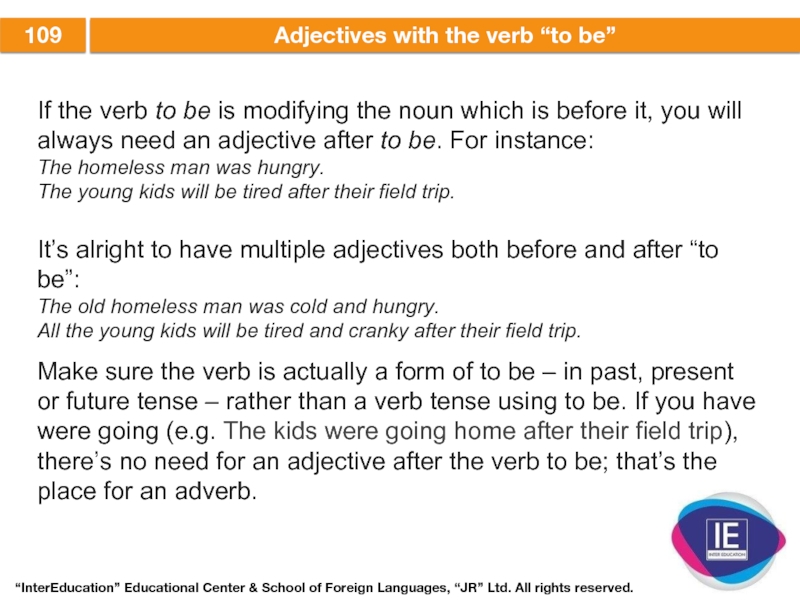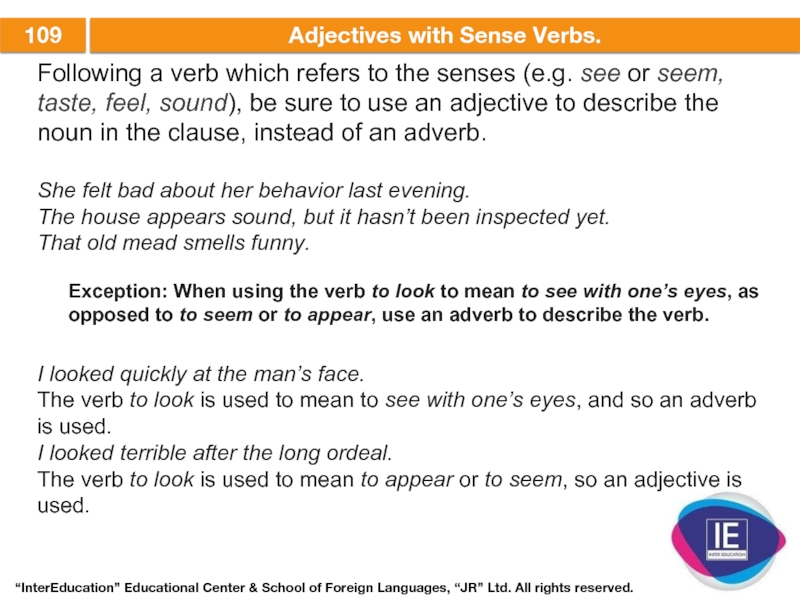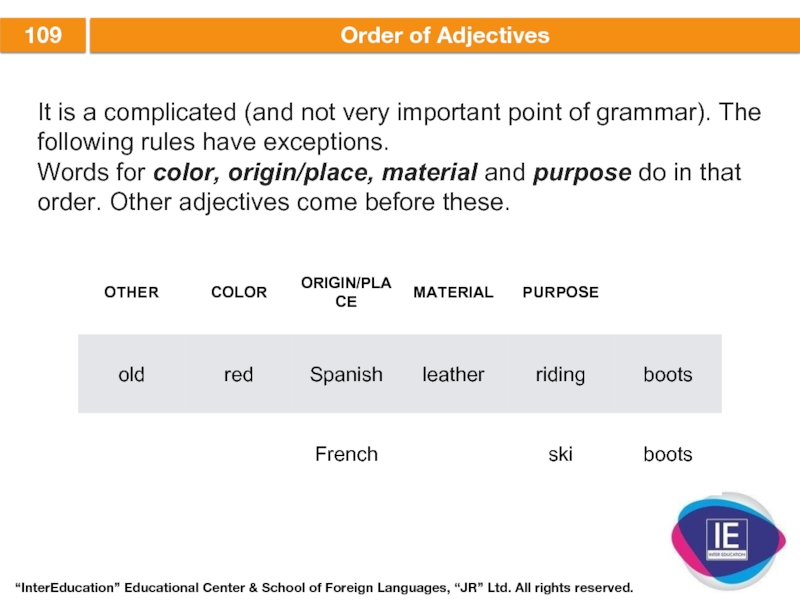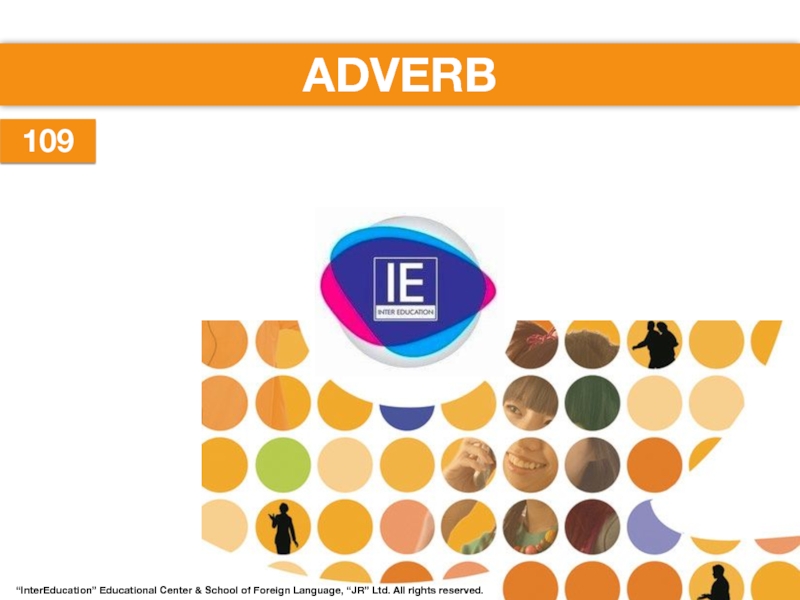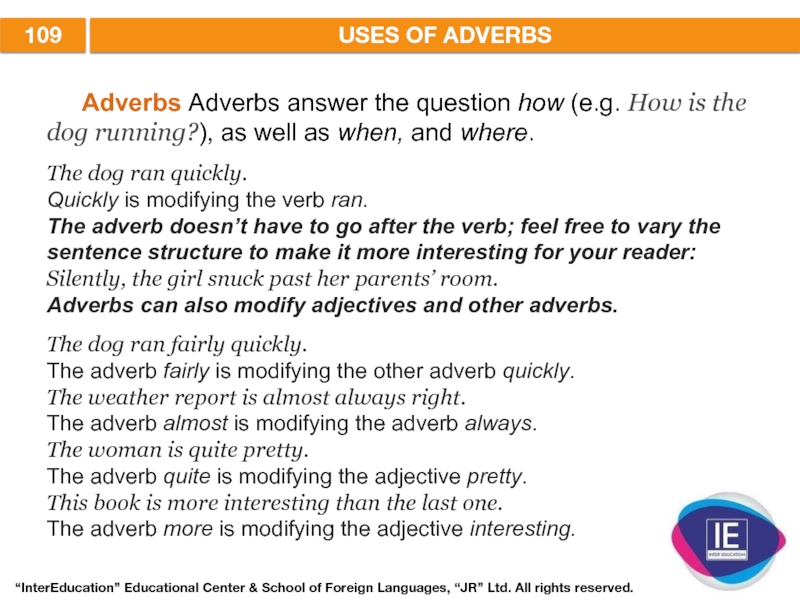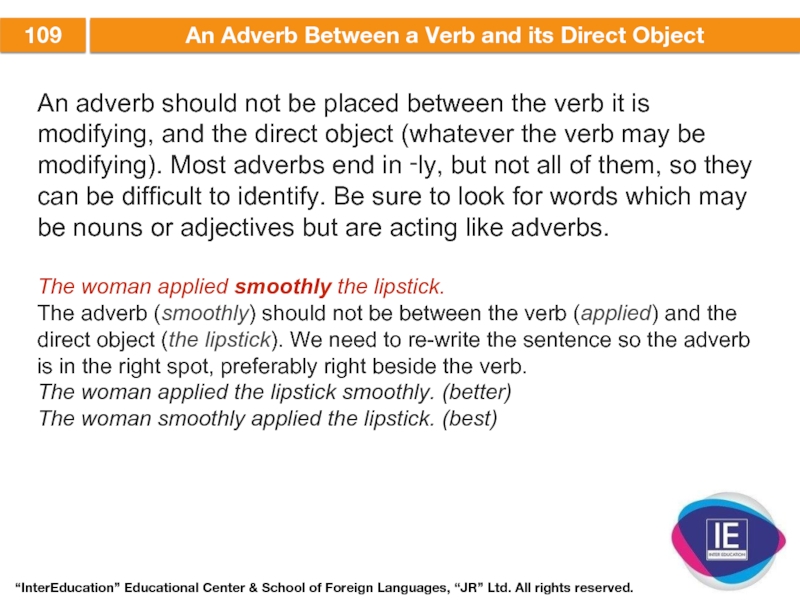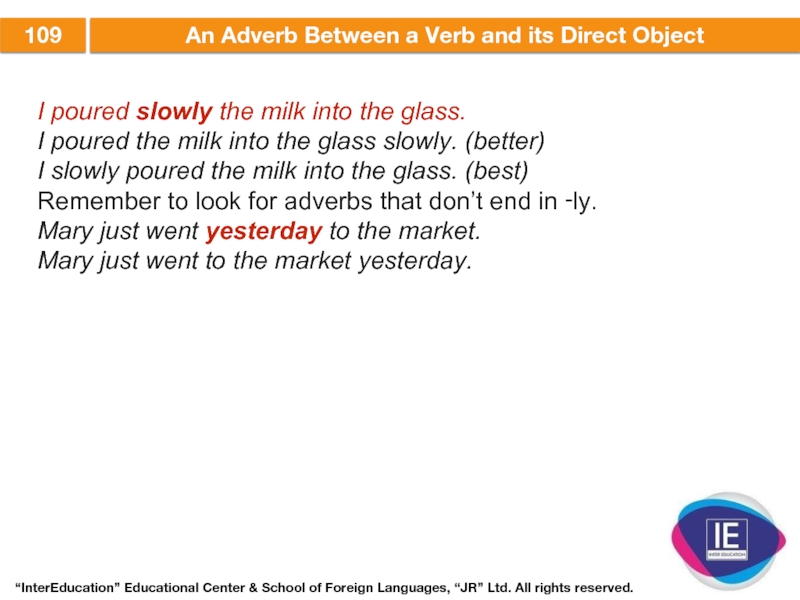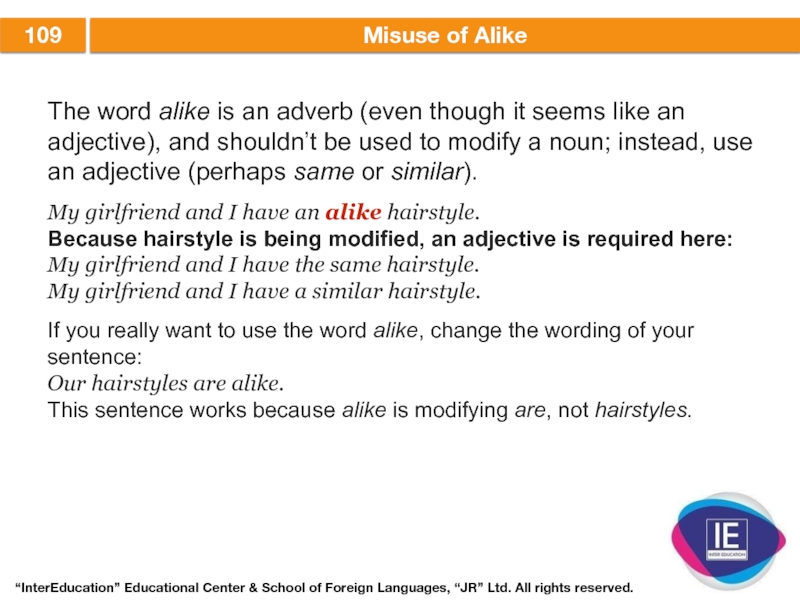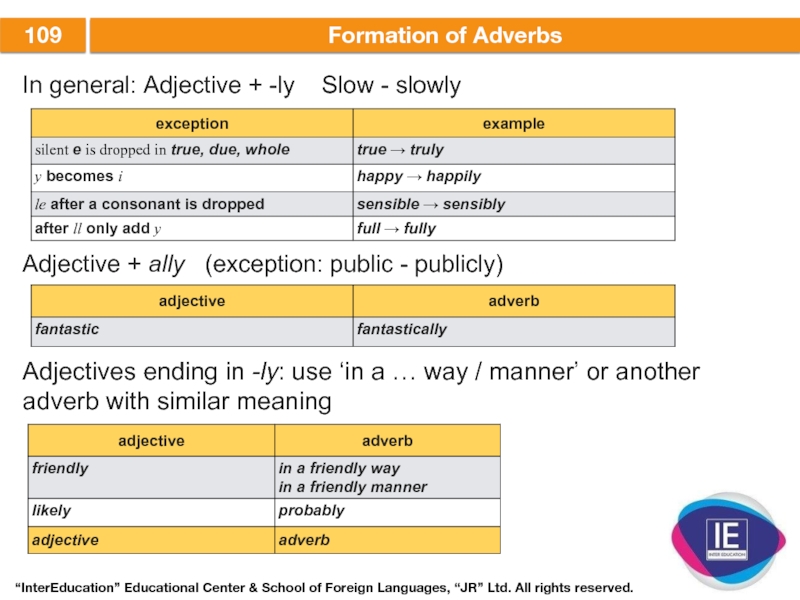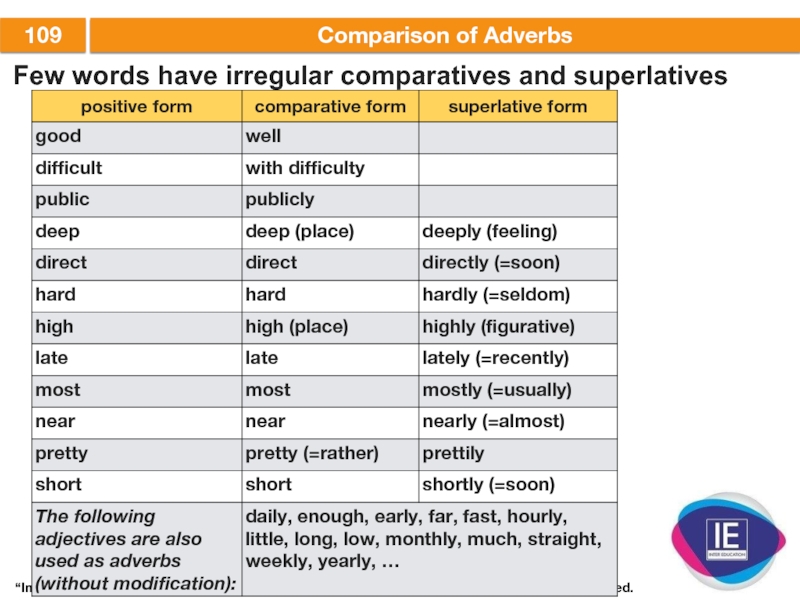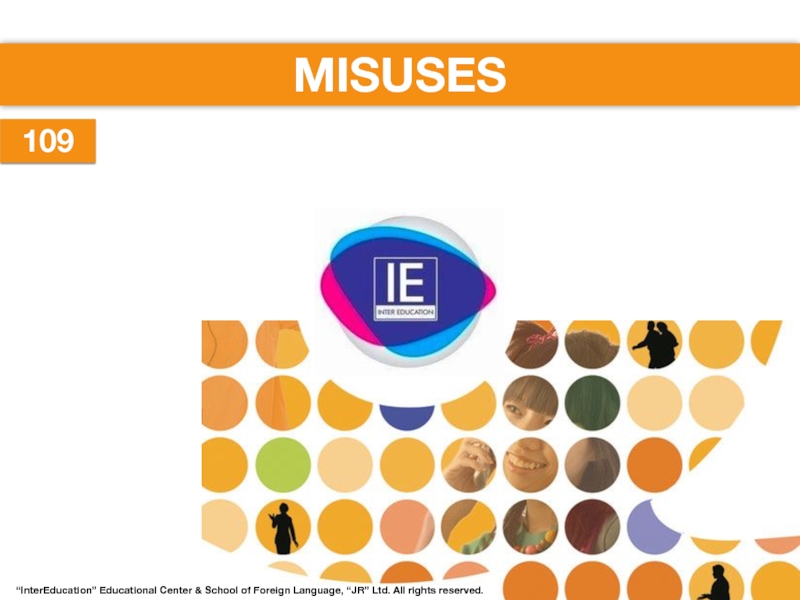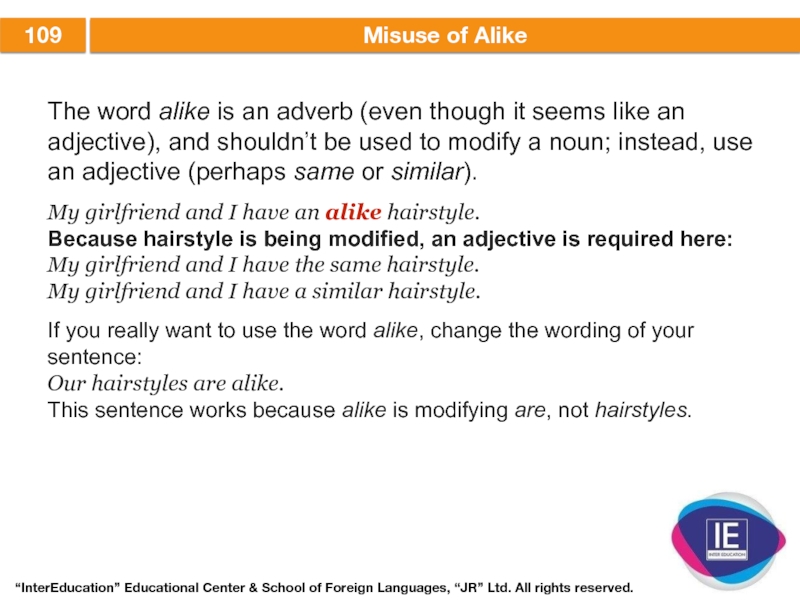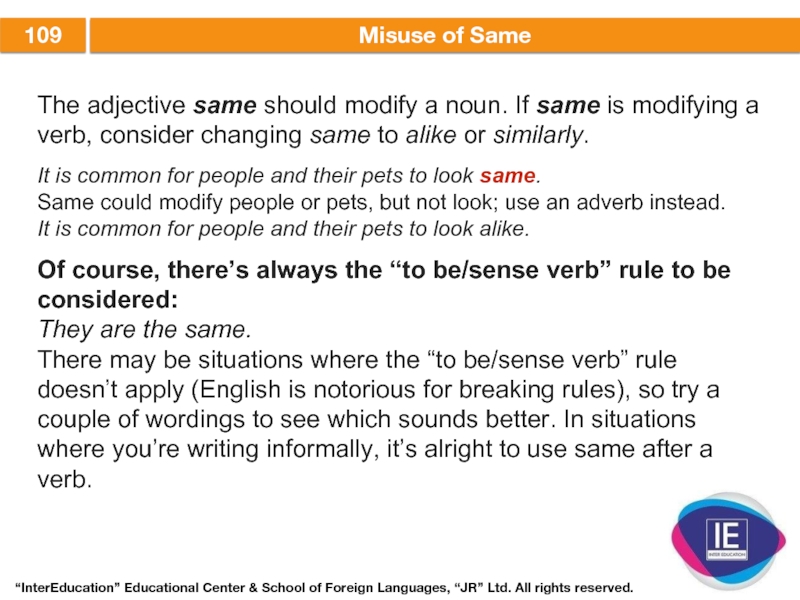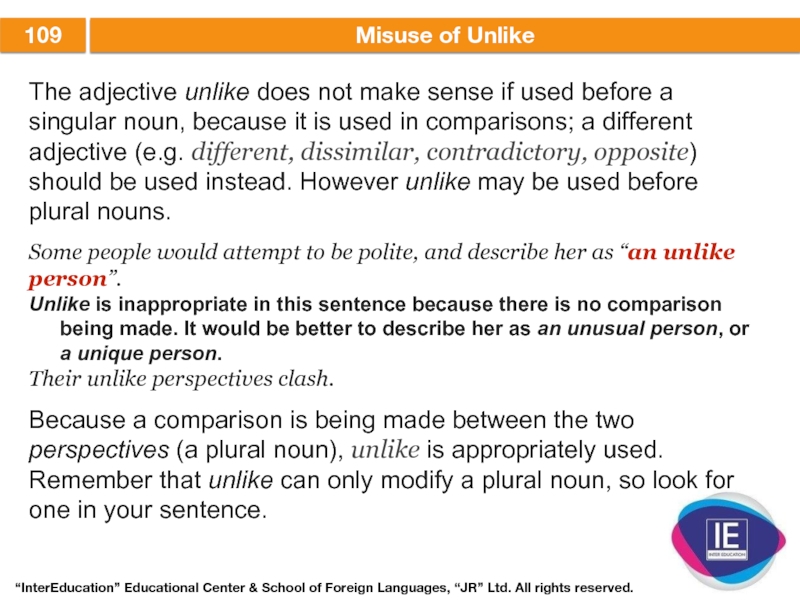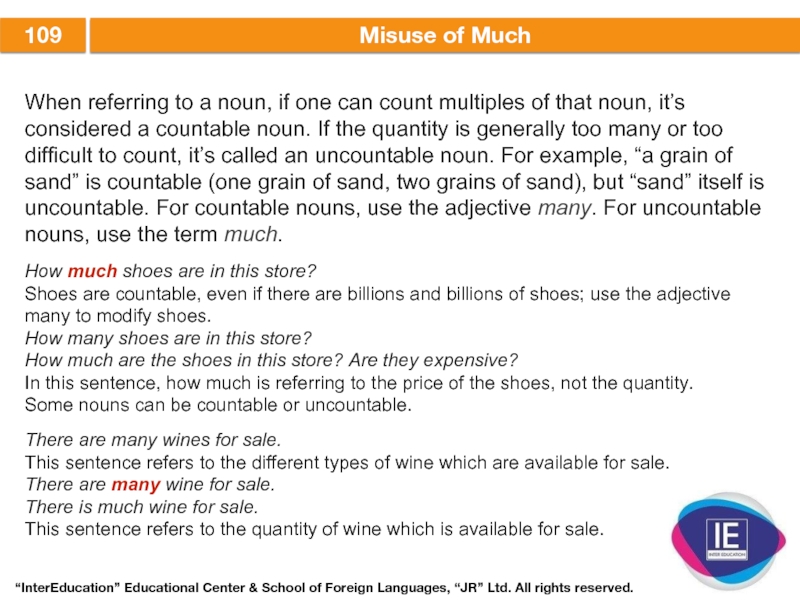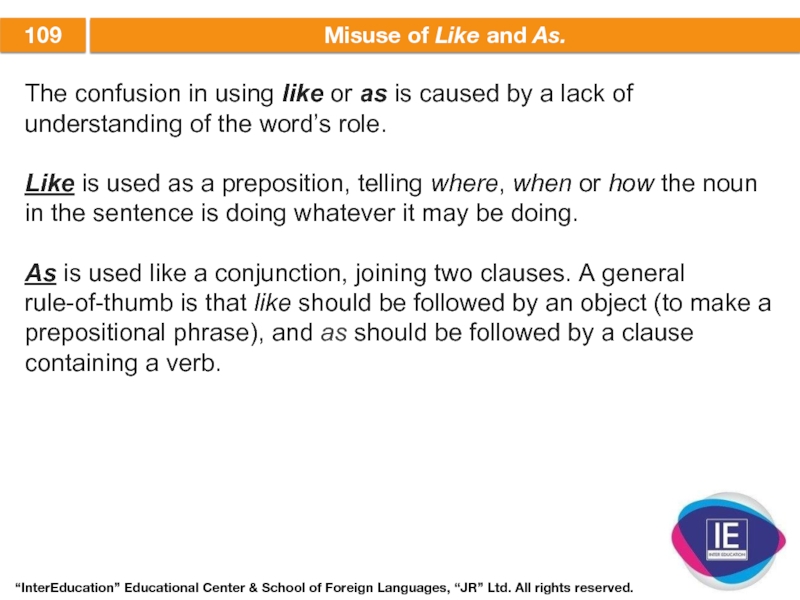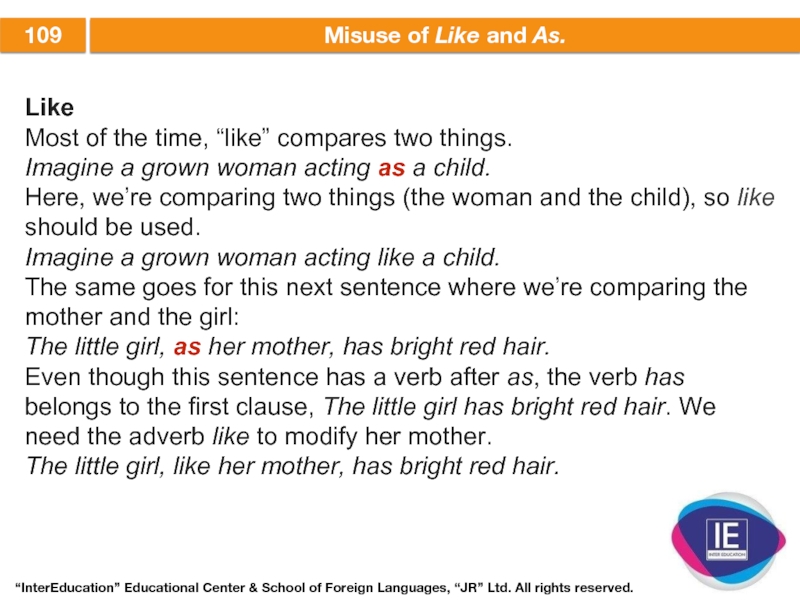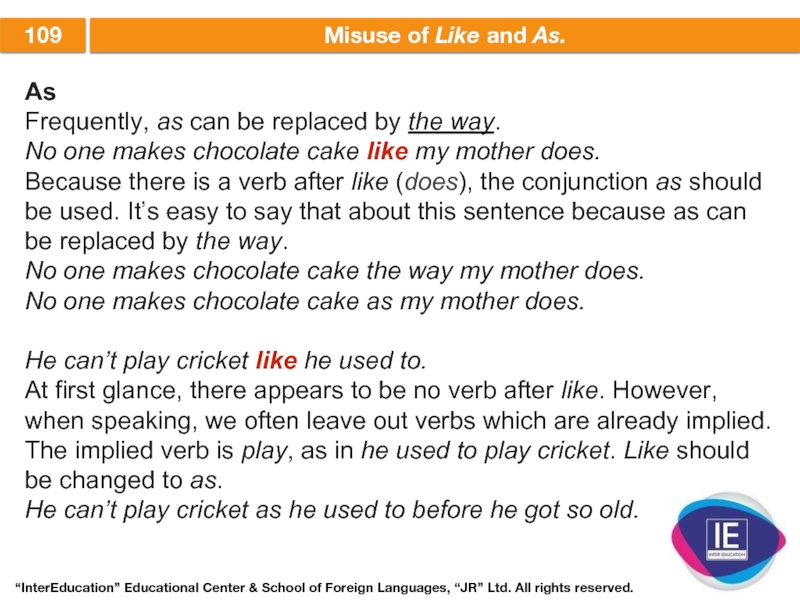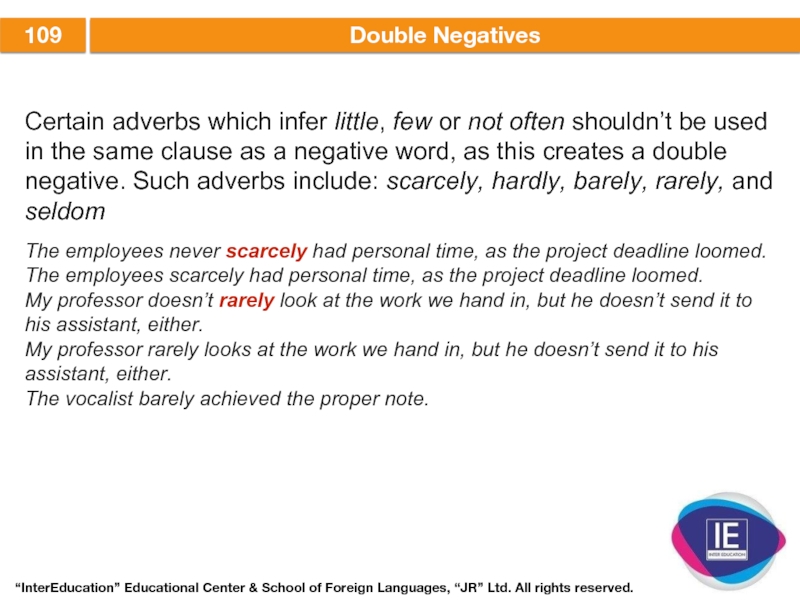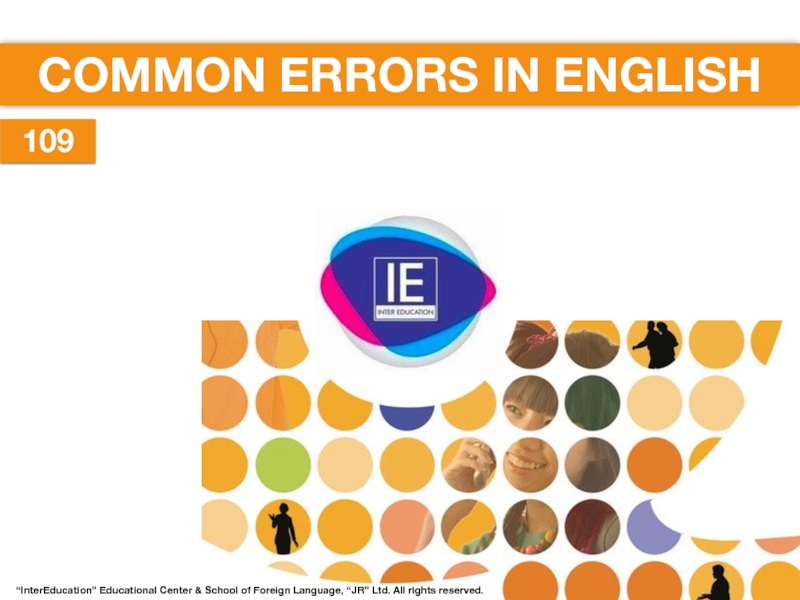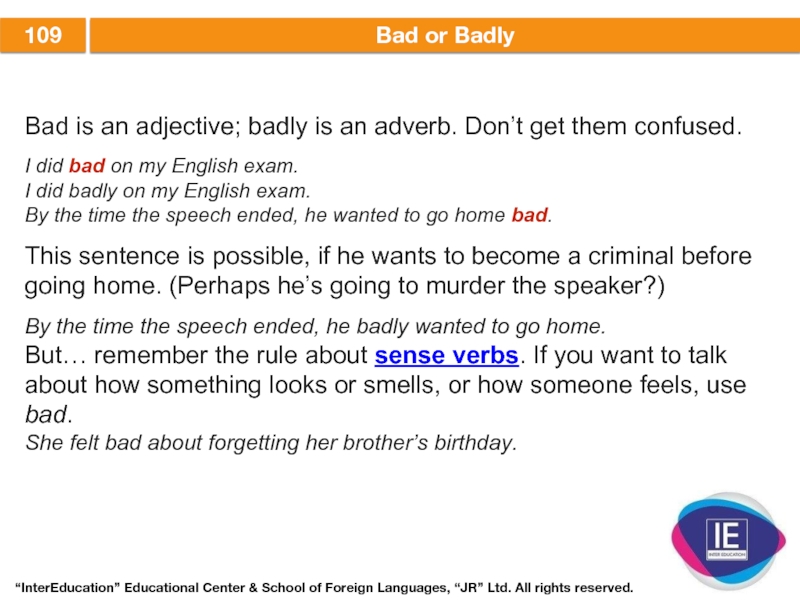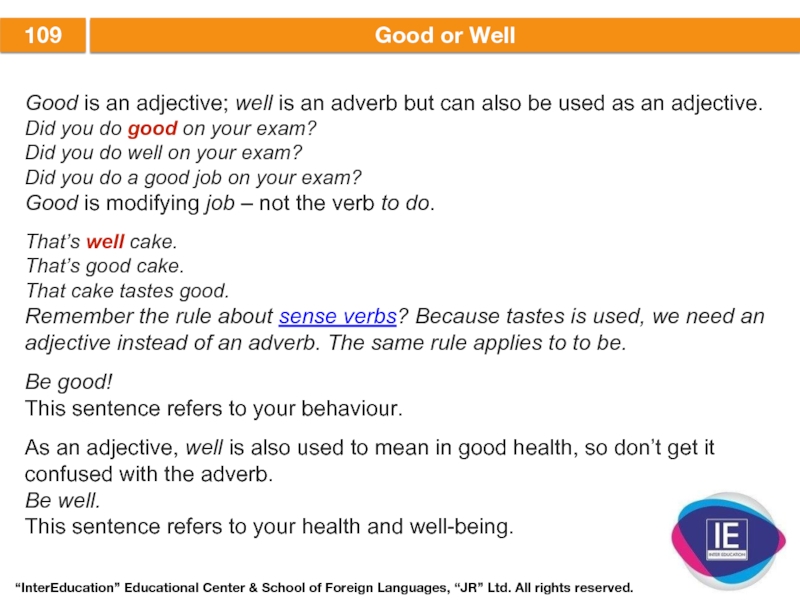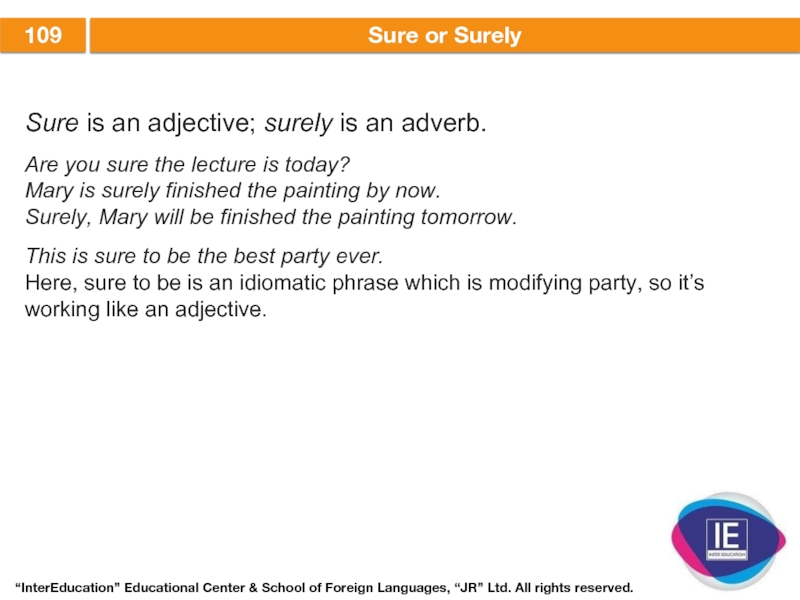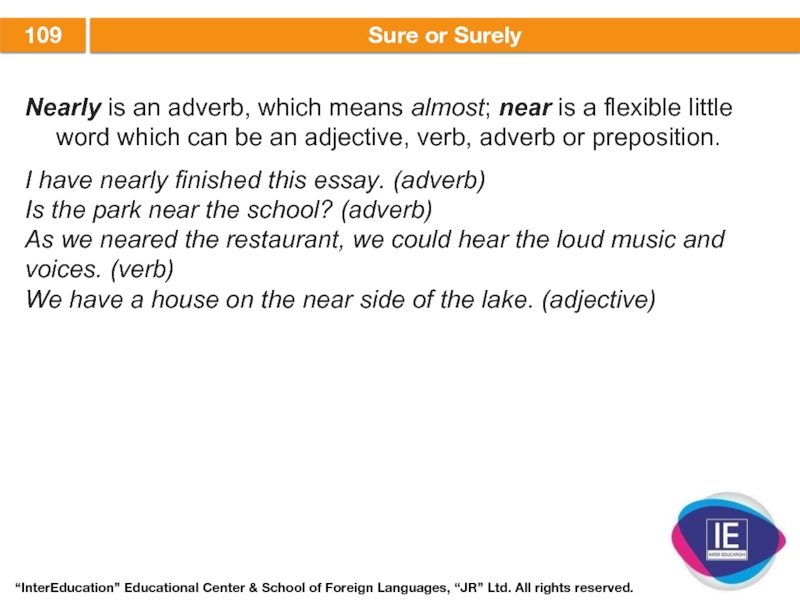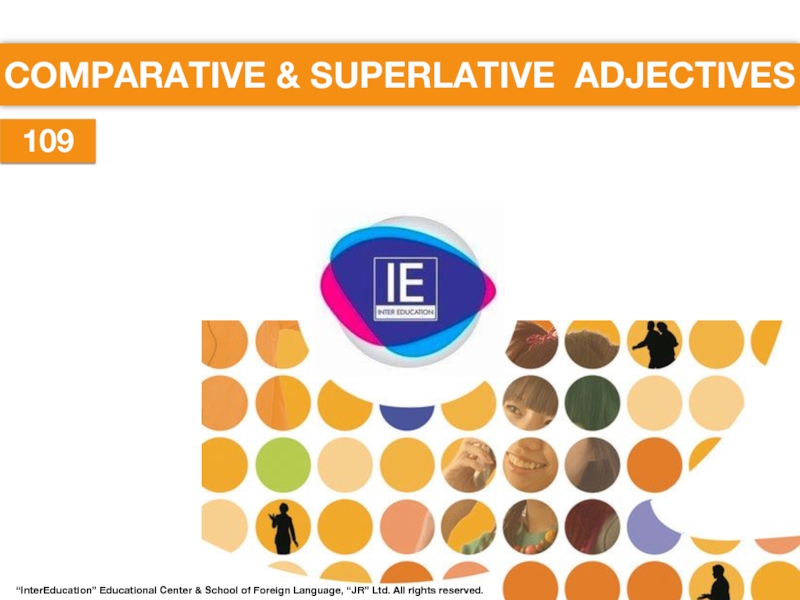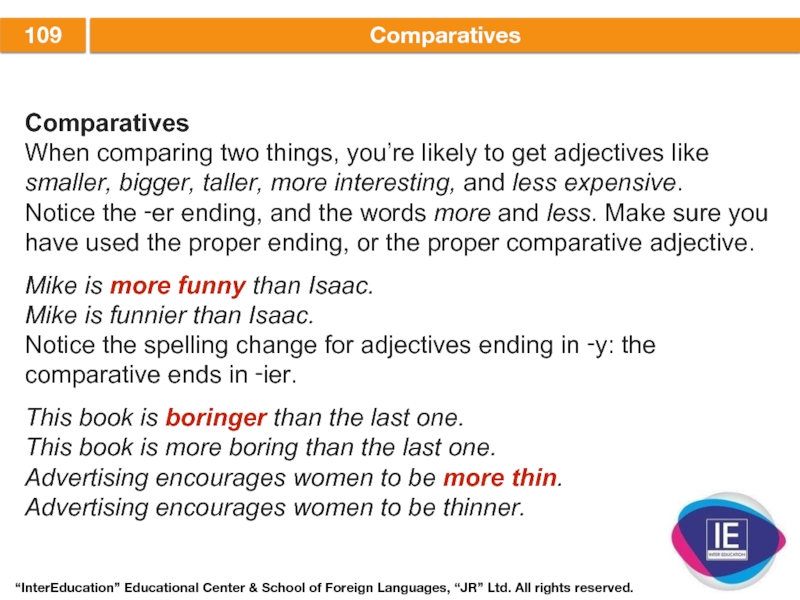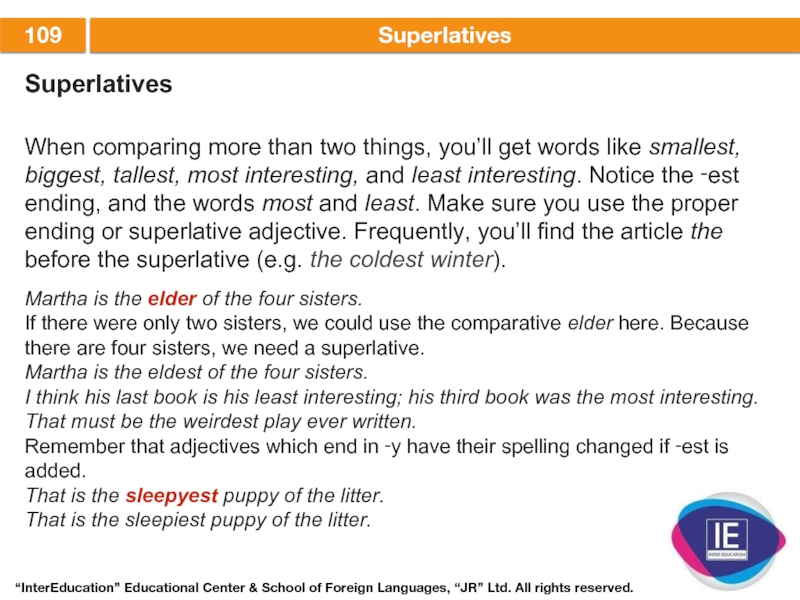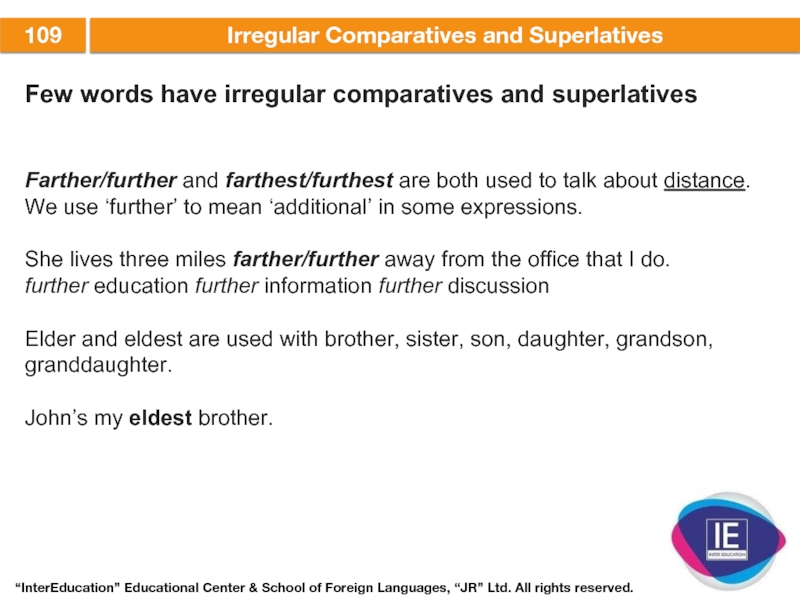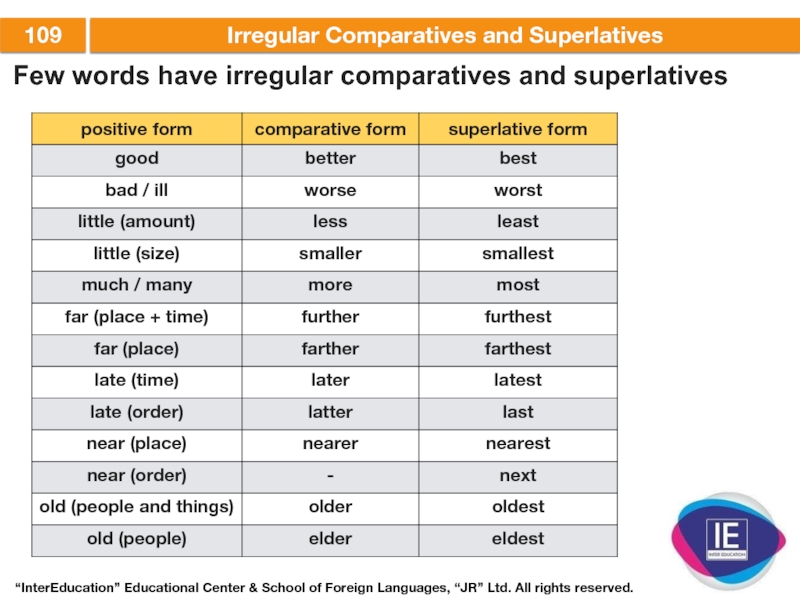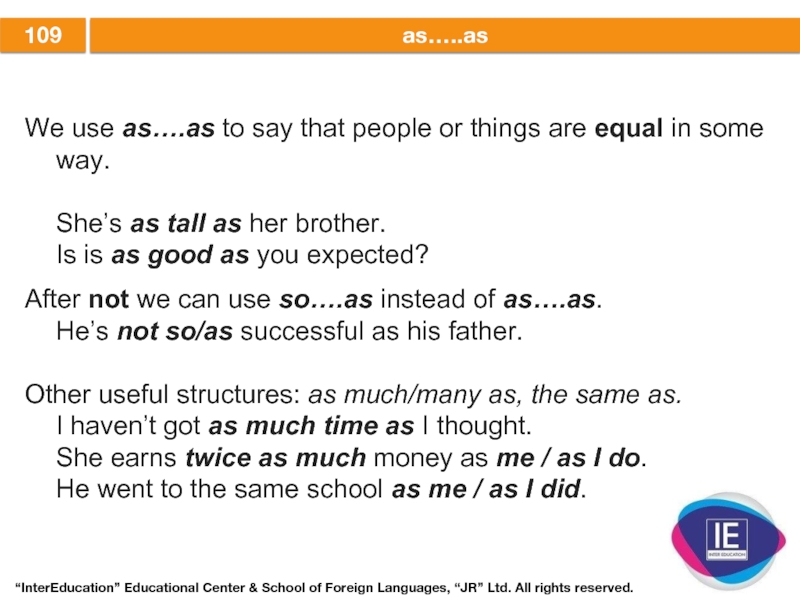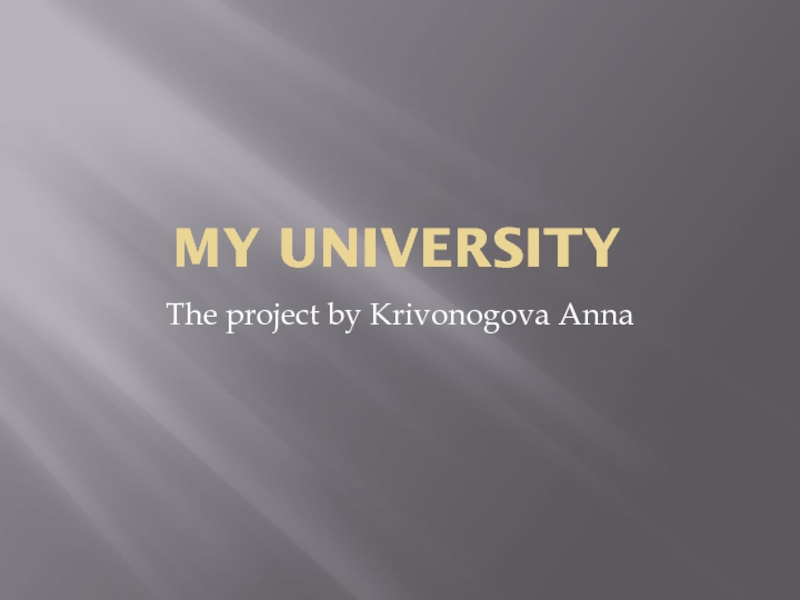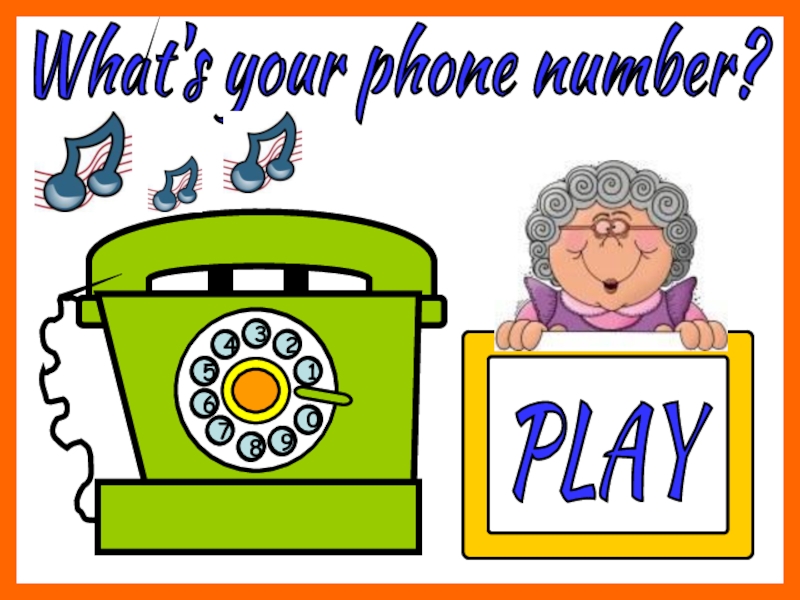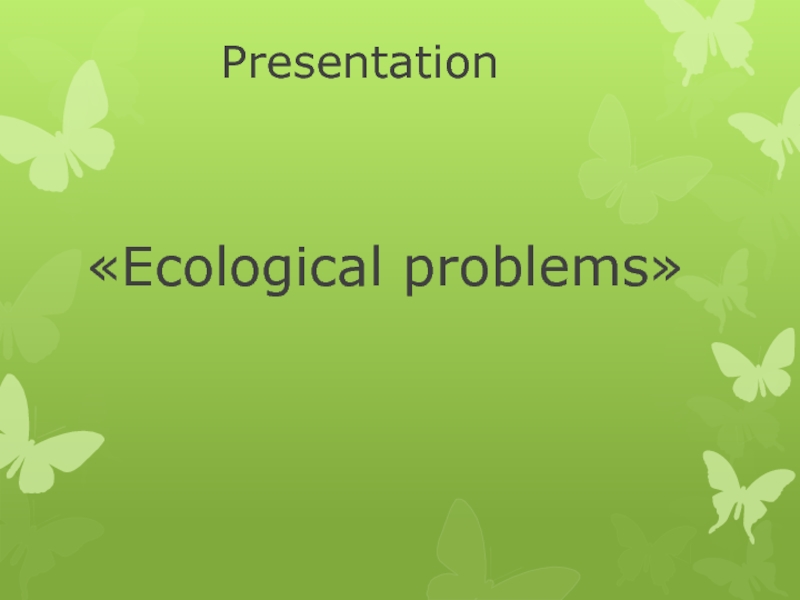Accredited by:
- Главная
- Разное
- Дизайн
- Бизнес и предпринимательство
- Аналитика
- Образование
- Развлечения
- Красота и здоровье
- Финансы
- Государство
- Путешествия
- Спорт
- Недвижимость
- Армия
- Графика
- Культурология
- Еда и кулинария
- Лингвистика
- Английский язык
- Астрономия
- Алгебра
- Биология
- География
- Детские презентации
- Информатика
- История
- Литература
- Маркетинг
- Математика
- Медицина
- Менеджмент
- Музыка
- МХК
- Немецкий язык
- ОБЖ
- Обществознание
- Окружающий мир
- Педагогика
- Русский язык
- Технология
- Физика
- Философия
- Химия
- Шаблоны, картинки для презентаций
- Экология
- Экономика
- Юриспруденция
InterEducation” | Educational Center & School of Foreign Languages презентация
Содержание
- 1. InterEducation” | Educational Center & School of Foreign Languages
- 2. ADJECTIVES & ADVERBS 109 “InterEducation” Educational Center
- 3. 109 “InterEducation” Educational Center & School of
- 4. ADJECTIVES 109 “InterEducation” Educational Center & School of Foreign Language, “JR” Ltd. All rights reserved.
- 5. 109 “InterEducation” Educational Center & School of
- 6. 109 “InterEducation” Educational Center & School of
- 7. 109 “InterEducation” Educational Center & School of
- 8. 109 “InterEducation” Educational Center & School of
- 9. 109 “InterEducation” Educational Center & School of
- 10. 109 “InterEducation” Educational Center & School of
- 11. 109 “InterEducation” Educational Center & School of
- 12. 109 “InterEducation” Educational Center & School of
- 13. ADVERB 109 “InterEducation” Educational Center & School of Foreign Language, “JR” Ltd. All rights reserved.
- 14. 109 “InterEducation” Educational Center & School of
- 15. 109 “InterEducation” Educational Center & School of
- 16. 109 “InterEducation” Educational Center & School of
- 17. 109 “InterEducation” Educational Center & School of
- 18. 109 “InterEducation” Educational Center & School of
- 19. 109 “InterEducation” Educational Center & School of
- 20. 109 “InterEducation” Educational Center & School of
- 21. MISUSES 109 “InterEducation” Educational Center &
- 22. 109 “InterEducation” Educational Center & School of
- 23. 109 “InterEducation” Educational Center & School of
- 24. 109 “InterEducation” Educational Center & School of
- 25. 109 “InterEducation” Educational Center & School of
- 26. 109 “InterEducation” Educational Center & School of
- 27. 109 “InterEducation” Educational Center & School of
- 28. 109 “InterEducation” Educational Center & School of
- 29. 109 “InterEducation” Educational Center & School of
- 30. COMMON ERRORS IN ENGLISH 109 “InterEducation”
- 31. 109 “InterEducation” Educational Center & School of
- 32. 109 “InterEducation” Educational Center & School of
- 33. 109 “InterEducation” Educational Center & School of
- 34. 109 “InterEducation” Educational Center & School of
- 35. COMPARATIVE & SUPERLATIVE ADJECTIVES 109 “InterEducation” Educational
- 36. 109 “InterEducation” Educational Center & School of
- 37. 109 “InterEducation” Educational Center & School of
- 38. 109 “InterEducation” Educational Center & School of
- 39. 109 “InterEducation” Educational Center & School of
- 40. 109 “InterEducation” Educational Center & School of
Слайд 1“InterEducation” | Educational Center & School of Foreign Languages
“InterEducation” Educational Center
Слайд 2ADJECTIVES & ADVERBS
109
“InterEducation” Educational Center & School of Foreign Language, “JR”
Слайд 3109
“InterEducation” Educational Center & School of Foreign Languages, “JR” Ltd. All
Adjectives & Adverbs
Adjectives and adverbs are – absolutely – a necessary component of writing. It’s fine to say that they “just add details”, but the details are what completes the communication of information to the reader. They help the reader create an image and understand precisely what the writer is saying.
As a general rule, it’s easy to identify adjectives (which modify nouns) and adverbs (which modify verbs). The only caution one must exercise is in not confusing the two, as is commonly done in casual speech
Слайд 4ADJECTIVES
109
“InterEducation” Educational Center & School of Foreign Language, “JR” Ltd. All
Слайд 5109
“InterEducation” Educational Center & School of Foreign Languages, “JR” Ltd. All
Adjectives & Adverbs
An adjective is a word or set of words that modifies (i.e., describes) a noun or pronoun. Adjectives may come before the word they modify.
Examples:
That is a cute puppy.
She likes a high school senior.
Adjectives may also follow the word they modify:
Examples:
That puppy looks cute.
The technology is state-of-the-art.
Слайд 6109
“InterEducation” Educational Center & School of Foreign Languages, “JR” Ltd. All
USES OF ADJECTIVES
An adjective can tell the reader how much – or how many – of something you’re talking about, which thing you want passed to you, or which kind you want.
Please use three white flowers in the arrangement.
Three and white are modifying flowers.
If you are using multiple adjectives which are commonly put together, there’s no need for a comma between the adjectives.
Look at that sweet little puppy!
If the adjectives aren’t usually used together, separate them with a comma or conjunction.
I’m looking for a small, good-tempered dog to keep as a pet.
My new dog is small and good-tempered.
Слайд 7109
“InterEducation” Educational Center & School of Foreign Languages, “JR” Ltd. All
USES OF ADJECTIVES
Adjectives usually go before the noun (e.g. small child) unless one of the following verbs are involved: be, feel, taste, smell, sound, look, appear, seem. In these cases, the adjectives work more like adverbs.
The child is small.
The child seems small.
Слайд 8109
“InterEducation” Educational Center & School of Foreign Languages, “JR” Ltd. All
Adjectives and Verbs
There are two things to consider when contemplating the relationship between adjectives and verbs. The first is that adjectives can come after the verb:
The rock star was crazy.
The cat’s tail is long.
The cookies smell awesome!
That shirt looks great on you..
Note that these are forms of to be or “sense” verbs: to look, to seem, to appear, to taste, to sound, to feel, to smell, etc. If these verbs are modifying the noun in front of them, an adjective will always be required so the noun is properly modified.
Слайд 9109
“InterEducation” Educational Center & School of Foreign Languages, “JR” Ltd. All
Adjectives and Verbs
The second thing to consider is verbs that turn into adjectives; these are called participles. Usually, the verb has ‑ing tacked onto the end of the root form, or it’s the past tense. The adjective can be placed before the noun or after the verb.
The smiling baby is really cute.
Smiling is used as an adjective here, as is cute.
This is my new washing machine.
Washing is acting like an adjective for machine.
This is my broken washing machine.
This washing machine is broken.
Broken is an adjective which is modifying washing machine.
Слайд 10109
“InterEducation” Educational Center & School of Foreign Languages, “JR” Ltd. All
Adjectives with the verb “to be”
If the verb to be is modifying the noun which is before it, you will always need an adjective after to be. For instance:
The homeless man was hungry.
The young kids will be tired after their field trip.
It’s alright to have multiple adjectives both before and after “to be”:
The old homeless man was cold and hungry.
All the young kids will be tired and cranky after their field trip.
Make sure the verb is actually a form of to be – in past, present or future tense – rather than a verb tense using to be. If you have were going (e.g. The kids were going home after their field trip), there’s no need for an adjective after the verb to be; that’s the place for an adverb.
Слайд 11109
“InterEducation” Educational Center & School of Foreign Languages, “JR” Ltd. All
Adjectives with Sense Verbs.
Following a verb which refers to the senses (e.g. see or seem, taste, feel, sound), be sure to use an adjective to describe the noun in the clause, instead of an adverb.
She felt bad about her behavior last evening.
The house appears sound, but it hasn’t been inspected yet.
That old mead smells funny.
Exception: When using the verb to look to mean to see with one’s eyes, as opposed to to seem or to appear, use an adverb to describe the verb.
I looked quickly at the man’s face.
The verb to look is used to mean to see with one’s eyes, and so an adverb is used.
I looked terrible after the long ordeal.
The verb to look is used to mean to appear or to seem, so an adjective is used.
Слайд 12109
“InterEducation” Educational Center & School of Foreign Languages, “JR” Ltd. All
Order of Adjectives
It is a complicated (and not very important point of grammar). The following rules have exceptions.
Words for color, origin/place, material and purpose do in that order. Other adjectives come before these.
Слайд 13ADVERB
109
“InterEducation” Educational Center & School of Foreign Language, “JR” Ltd. All
Слайд 14109
“InterEducation” Educational Center & School of Foreign Languages, “JR” Ltd. All
Adjectives & Adverbs
An adverb is a word or set of words that modifies verbs, adjectives, or other adverbs. Adverbs answer how, when, where, why, or to what extent—how often or how much (e.g., daily, completely).
Examples:
He speaks slowly (tells how)
He speaks very slowly (the adverb very tells how slowly)
She arrived today (tells when)
She will arrive in an hour (this adverb phrase tells when)
Let's go outside (tells where)
We looked in the basement (this adverb phrase tells where)
Bernie left to avoid trouble (this adverb phrase tells why)
Jorge works out strenuously (tells to what extent)
Jorge works out whenever possible (this adverb phrase tells to what extent)
Слайд 15109
“InterEducation” Educational Center & School of Foreign Languages, “JR” Ltd. All
USES OF ADVERBS
Adverbs Adverbs answer the question how (e.g. How is the dog running?), as well as when, and where.
The dog ran quickly.
Quickly is modifying the verb ran.
The adverb doesn’t have to go after the verb; feel free to vary the sentence structure to make it more interesting for your reader:
Silently, the girl snuck past her parents’ room.
Adverbs can also modify adjectives and other adverbs.
The dog ran fairly quickly.
The adverb fairly is modifying the other adverb quickly.
The weather report is almost always right.
The adverb almost is modifying the adverb always.
The woman is quite pretty.
The adverb quite is modifying the adjective pretty.
This book is more interesting than the last one.
The adverb more is modifying the adjective interesting.
Слайд 16109
“InterEducation” Educational Center & School of Foreign Languages, “JR” Ltd. All
An Adverb Between a Verb and its Direct Object
An adverb should not be placed between the verb it is modifying, and the direct object (whatever the verb may be modifying). Most adverbs end in ‑ly, but not all of them, so they can be difficult to identify. Be sure to look for words which may be nouns or adjectives but are acting like adverbs.
The woman applied smoothly the lipstick.
The adverb (smoothly) should not be between the verb (applied) and the direct object (the lipstick). We need to re-write the sentence so the adverb is in the right spot, preferably right beside the verb.
The woman applied the lipstick smoothly. (better)
The woman smoothly applied the lipstick. (best)
Слайд 17109
“InterEducation” Educational Center & School of Foreign Languages, “JR” Ltd. All
An Adverb Between a Verb and its Direct Object
I poured slowly the milk into the glass.
I poured the milk into the glass slowly. (better)
I slowly poured the milk into the glass. (best)
Remember to look for adverbs that don’t end in ‑ly.
Mary just went yesterday to the market.
Mary just went to the market yesterday.
Слайд 18109
“InterEducation” Educational Center & School of Foreign Languages, “JR” Ltd. All
Misuse of Alike
The word alike is an adverb (even though it seems like an adjective), and shouldn’t be used to modify a noun; instead, use an adjective (perhaps same or similar).
My girlfriend and I have an alike hairstyle.
Because hairstyle is being modified, an adjective is required here:
My girlfriend and I have the same hairstyle.
My girlfriend and I have a similar hairstyle.
If you really want to use the word alike, change the wording of your sentence:
Our hairstyles are alike.
This sentence works because alike is modifying are, not hairstyles.
Слайд 19109
“InterEducation” Educational Center & School of Foreign Languages, “JR” Ltd. All
Formation of Adverbs
In general: Adjective + -ly Slow - slowly
Adjective + ally (exception: public - publicly)
Adjectives ending in -ly: use ‘in a … way / manner’ or another adverb with similar meaning
Слайд 20109
“InterEducation” Educational Center & School of Foreign Languages, “JR” Ltd. All
Comparison of Adverbs
Few words have irregular comparatives and superlatives
Слайд 21MISUSES
109
“InterEducation” Educational Center & School of Foreign Language, “JR” Ltd.
Слайд 22109
“InterEducation” Educational Center & School of Foreign Languages, “JR” Ltd. All
Misuse of Alike
The word alike is an adverb (even though it seems like an adjective), and shouldn’t be used to modify a noun; instead, use an adjective (perhaps same or similar).
My girlfriend and I have an alike hairstyle.
Because hairstyle is being modified, an adjective is required here:
My girlfriend and I have the same hairstyle.
My girlfriend and I have a similar hairstyle.
If you really want to use the word alike, change the wording of your sentence:
Our hairstyles are alike.
This sentence works because alike is modifying are, not hairstyles.
Слайд 23109
“InterEducation” Educational Center & School of Foreign Languages, “JR” Ltd. All
Misuse of Same
The adjective same should modify a noun. If same is modifying a verb, consider changing same to alike or similarly.
It is common for people and their pets to look same.
Same could modify people or pets, but not look; use an adverb instead.
It is common for people and their pets to look alike.
Of course, there’s always the “to be/sense verb” rule to be considered:
They are the same.
There may be situations where the “to be/sense verb” rule doesn’t apply (English is notorious for breaking rules), so try a couple of wordings to see which sounds better. In situations where you’re writing informally, it’s alright to use same after a verb.
Слайд 24109
“InterEducation” Educational Center & School of Foreign Languages, “JR” Ltd. All
Misuse of Unlike
The adjective unlike does not make sense if used before a singular noun, because it is used in comparisons; a different adjective (e.g. different, dissimilar, contradictory, opposite) should be used instead. However unlike may be used before plural nouns.
Some people would attempt to be polite, and describe her as “an unlike person”.
Unlike is inappropriate in this sentence because there is no comparison being made. It would be better to describe her as an unusual person, or a unique person.
Their unlike perspectives clash.
Because a comparison is being made between the two perspectives (a plural noun), unlike is appropriately used.
Remember that unlike can only modify a plural noun, so look for one in your sentence.
Слайд 25109
“InterEducation” Educational Center & School of Foreign Languages, “JR” Ltd. All
Misuse of Much
When referring to a noun, if one can count multiples of that noun, it’s considered a countable noun. If the quantity is generally too many or too difficult to count, it’s called an uncountable noun. For example, “a grain of sand” is countable (one grain of sand, two grains of sand), but “sand” itself is uncountable. For countable nouns, use the adjective many. For uncountable nouns, use the term much.
How much shoes are in this store?
Shoes are countable, even if there are billions and billions of shoes; use the adjective many to modify shoes.
How many shoes are in this store?
How much are the shoes in this store? Are they expensive?
In this sentence, how much is referring to the price of the shoes, not the quantity.
Some nouns can be countable or uncountable.
There are many wines for sale.
This sentence refers to the different types of wine which are available for sale.
There are many wine for sale.
There is much wine for sale.
This sentence refers to the quantity of wine which is available for sale.
Слайд 26109
“InterEducation” Educational Center & School of Foreign Languages, “JR” Ltd. All
Misuse of Like and As.
The confusion in using like or as is caused by a lack of understanding of the word’s role.
Like is used as a preposition, telling where, when or how the noun in the sentence is doing whatever it may be doing.
As is used like a conjunction, joining two clauses. A general rule-of-thumb is that like should be followed by an object (to make a prepositional phrase), and as should be followed by a clause containing a verb.
Слайд 27109
“InterEducation” Educational Center & School of Foreign Languages, “JR” Ltd. All
Misuse of Like and As.
Like
Most of the time, “like” compares two things.
Imagine a grown woman acting as a child.
Here, we’re comparing two things (the woman and the child), so like should be used.
Imagine a grown woman acting like a child.
The same goes for this next sentence where we’re comparing the mother and the girl:
The little girl, as her mother, has bright red hair.
Even though this sentence has a verb after as, the verb has belongs to the first clause, The little girl has bright red hair. We need the adverb like to modify her mother.
The little girl, like her mother, has bright red hair.
Слайд 28109
“InterEducation” Educational Center & School of Foreign Languages, “JR” Ltd. All
Misuse of Like and As.
As
Frequently, as can be replaced by the way.
No one makes chocolate cake like my mother does.
Because there is a verb after like (does), the conjunction as should be used. It’s easy to say that about this sentence because as can be replaced by the way.
No one makes chocolate cake the way my mother does.
No one makes chocolate cake as my mother does.
He can’t play cricket like he used to.
At first glance, there appears to be no verb after like. However, when speaking, we often leave out verbs which are already implied. The implied verb is play, as in he used to play cricket. Like should be changed to as.
He can’t play cricket as he used to before he got so old.
Слайд 29109
“InterEducation” Educational Center & School of Foreign Languages, “JR” Ltd. All
Double Negatives
Certain adverbs which infer little, few or not often shouldn’t be used in the same clause as a negative word, as this creates a double negative. Such adverbs include: scarcely, hardly, barely, rarely, and seldom
The employees never scarcely had personal time, as the project deadline loomed.
The employees scarcely had personal time, as the project deadline loomed.
My professor doesn’t rarely look at the work we hand in, but he doesn’t send it to his assistant, either.
My professor rarely looks at the work we hand in, but he doesn’t send it to his assistant, either.
The vocalist barely achieved the proper note.
Слайд 30COMMON ERRORS IN ENGLISH
109
“InterEducation” Educational Center & School of Foreign
Слайд 31109
“InterEducation” Educational Center & School of Foreign Languages, “JR” Ltd. All
Bad or Badly
Bad is an adjective; badly is an adverb. Don’t get them confused.
I did bad on my English exam.
I did badly on my English exam.
By the time the speech ended, he wanted to go home bad.
This sentence is possible, if he wants to become a criminal before going home. (Perhaps he’s going to murder the speaker?)
By the time the speech ended, he badly wanted to go home.
But… remember the rule about sense verbs. If you want to talk about how something looks or smells, or how someone feels, use bad.
She felt bad about forgetting her brother’s birthday.
Слайд 32109
“InterEducation” Educational Center & School of Foreign Languages, “JR” Ltd. All
Good or Well
Good is an adjective; well is an adverb but can also be used as an adjective.
Did you do good on your exam?
Did you do well on your exam?
Did you do a good job on your exam?
Good is modifying job – not the verb to do.
That’s well cake.
That’s good cake.
That cake tastes good.
Remember the rule about sense verbs? Because tastes is used, we need an adjective instead of an adverb. The same rule applies to to be.
Be good!
This sentence refers to your behaviour.
As an adjective, well is also used to mean in good health, so don’t get it confused with the adverb.
Be well.
This sentence refers to your health and well-being.
Слайд 33109
“InterEducation” Educational Center & School of Foreign Languages, “JR” Ltd. All
Sure or Surely
Sure is an adjective; surely is an adverb.
Are you sure the lecture is today?
Mary is surely finished the painting by now.
Surely, Mary will be finished the painting tomorrow.
This is sure to be the best party ever.
Here, sure to be is an idiomatic phrase which is modifying party, so it’s working like an adjective.
Слайд 34109
“InterEducation” Educational Center & School of Foreign Languages, “JR” Ltd. All
Sure or Surely
Nearly is an adverb, which means almost; near is a flexible little
word which can be an adjective, verb, adverb or preposition.
I have nearly finished this essay. (adverb)
Is the park near the school? (adverb)
As we neared the restaurant, we could hear the loud music and voices. (verb)
We have a house on the near side of the lake. (adjective)
Слайд 35COMPARATIVE & SUPERLATIVE ADJECTIVES
109
“InterEducation” Educational Center & School of Foreign Language,
Слайд 36109
“InterEducation” Educational Center & School of Foreign Languages, “JR” Ltd. All
Comparatives
Comparatives
When comparing two things, you’re likely to get adjectives like smaller, bigger, taller, more interesting, and less expensive.
Notice the ‑er ending, and the words more and less. Make sure you have used the proper ending, or the proper comparative adjective.
Mike is more funny than Isaac.
Mike is funnier than Isaac.
Notice the spelling change for adjectives ending in ‑y: the comparative ends in ‑ier.
This book is boringer than the last one.
This book is more boring than the last one.
Advertising encourages women to be more thin.
Advertising encourages women to be thinner.
Слайд 37109
“InterEducation” Educational Center & School of Foreign Languages, “JR” Ltd. All
Superlatives
Superlatives
When comparing more than two things, you’ll get words like smallest, biggest, tallest, most interesting, and least interesting. Notice the ‑est ending, and the words most and least. Make sure you use the proper ending or superlative adjective. Frequently, you’ll find the article the before the superlative (e.g. the coldest winter).
Martha is the elder of the four sisters.
If there were only two sisters, we could use the comparative elder here. Because there are four sisters, we need a superlative.
Martha is the eldest of the four sisters.
I think his last book is his least interesting; his third book was the most interesting.
That must be the weirdest play ever written.
Remember that adjectives which end in ‑y have their spelling changed if ‑est is added.
That is the sleepyest puppy of the litter.
That is the sleepiest puppy of the litter.
Слайд 38109
“InterEducation” Educational Center & School of Foreign Languages, “JR” Ltd. All
Irregular Comparatives and Superlatives
Few words have irregular comparatives and superlatives
Farther/further and farthest/furthest are both used to talk about distance.
We use ‘further’ to mean ‘additional’ in some expressions.
She lives three miles farther/further away from the office that I do.
further education further information further discussion
Elder and eldest are used with brother, sister, son, daughter, grandson, granddaughter.
John’s my eldest brother.
Слайд 39109
“InterEducation” Educational Center & School of Foreign Languages, “JR” Ltd. All
Irregular Comparatives and Superlatives
Few words have irregular comparatives and superlatives
Слайд 40109
“InterEducation” Educational Center & School of Foreign Languages, “JR” Ltd. All
as…..as
We use as….as to say that people or things are equal in some way.
She’s as tall as her brother.
Is is as good as you expected?
After not we can use so….as instead of as….as.
He’s not so/as successful as his father.
Other useful structures: as much/many as, the same as.
I haven’t got as much time as I thought.
She earns twice as much money as me / as I do.
He went to the same school as me / as I did.

